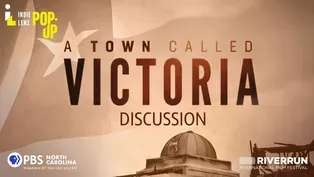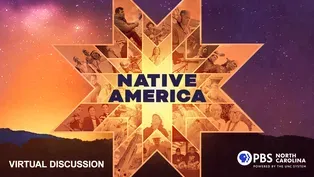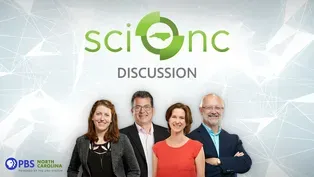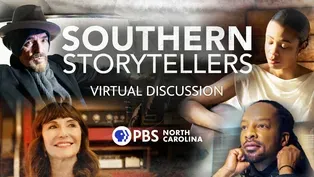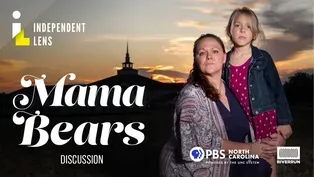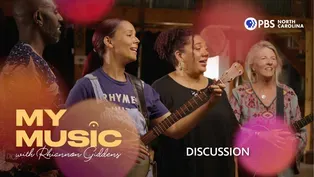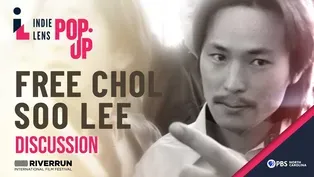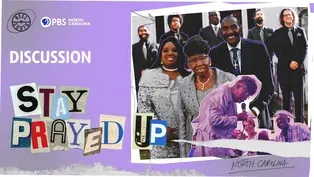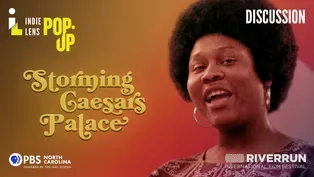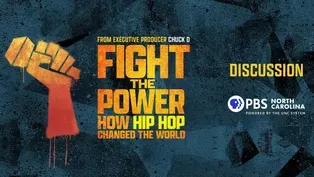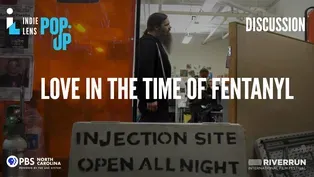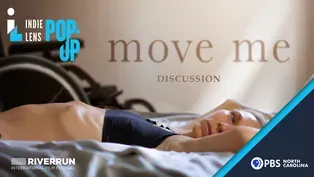PBS North Carolina Specials
Discussion | Visibly Speaking
5/10/2022 | 29m 21sVideo has Closed Captions
A panel discussion about an inclusive public art initiative in North Carolina.
A panel discussion about Z. Smith Reynold’s Inclusive Public Art initiative in North Carolina. Moderated by PBS NC’s Heather Burgiss, the discussion includes: Mo Green, executive director of the foundation; Kim Pevia, Public Art Advisory Council; and artists Cornelio Campos and Owens Daniels. They discuss the community impact of the art installations and how art brings history to life.
PBS North Carolina Specials
Discussion | Visibly Speaking
5/10/2022 | 29m 21sVideo has Closed Captions
A panel discussion about Z. Smith Reynold’s Inclusive Public Art initiative in North Carolina. Moderated by PBS NC’s Heather Burgiss, the discussion includes: Mo Green, executive director of the foundation; Kim Pevia, Public Art Advisory Council; and artists Cornelio Campos and Owens Daniels. They discuss the community impact of the art installations and how art brings history to life.
How to Watch PBS North Carolina Specials
PBS North Carolina Specials is available to stream on pbs.org and the free PBS App, available on iPhone, Apple TV, Android TV, Android smartphones, Amazon Fire TV, Amazon Fire Tablet, Roku, Samsung Smart TV, and Vizio.
Providing Support for PBS.org
Learn Moreabout PBS online sponsorshipMore from This Collection
Discussion - A Town Called Victoria - Independent Lens
Video has Closed Captions
The filmmaker and former Victoria residents share their story. (46m 51s)
Discussion - Native America Season 2
Video has Closed Captions
Panelists discuss preserving the languages of Native American tribes. (39m 1s)
Video has Closed Captions
Sci NC executive producer and host, Frank Graff, chats about upcoming Season 6 of Sci NC. (26m 6s)
Discussion - Southern Storytellers
Video has Closed Captions
Author David Joy and others discuss storytelling and their new PBS series. (42m 13s)
Discussion - Mama Bears | Independent Lens
Video has Closed Captions
Producer and director Daresha Kyi discusses the film and LGBTQIA+ advocacy. (34m 41s)
Discussion - My Music with Rhiannon Giddens
Video has Closed Captions
Discussing the series with producers Will & Deni McIntyre and country artist Rissi Palmer. (39m 56s)
Discussion - Free Chol Soo Lee | Independent Lens
Video has Closed Captions
Local lawyers, professors and nonprofit leaders discuss wrongful convictions and reentry. (40m 44s)
Discussion - Stay Prayed Up, Reel South
Video has Closed Captions
The filmmakers discuss their journey with Mother Perry and The Branchettes. (45m 4s)
Discussion - Storming Caesars Palace | Independent Lens
Video has Closed Captions
Local professors and nonprofit leaders discuss welfare and the social safety net. (33m 2s)
Discussion - Fight the Power: How Hip Hop Changed the World
Video has Closed Captions
Local experts discuss the history of hip hop with PBS North Carolina. (59m 43s)
Discussion - Love in the Time of Fentanyl | Independent Lens
Video has Closed Captions
Local harm reductionists, therapists and others discuss the opioid crisis and more. (55m 44s)
Discussion | Independent Lens: Move Me
Video has Closed Captions
A dancer with blindness and disability advocates discuss adaptable arts programs. (38m 46s)
Providing Support for PBS.org
Learn Moreabout PBS online sponsorship- Good evening.
We hope you've enjoyed this special screening of "Visibly Speaking," North Carolina's Inclusive Public Art Project.
I'm Heather Burgiss, Director of Original Productions at PBS, North Carolina.
We are so proud to bring this beautiful series to you in partnership with the Z. Smith Reynolds Foundation.
"Visibly Speaking" follows the creation of inclusive public art that honors the often overlooked stories of Black indigenous and Latinx communities.
Z. Smith Reynolds Investment, an inclusive public art aims to open the door to create courageous conversations, to share stories of diversity, equality, inclusion, and equity of the people and places of North Carolina.
And you will see how these 10 projects like the two that you've seen tonight highlight the power of public art and inclusive storytelling.
Joining me this evening for this conversation is Maurice Mo Green, Executive Director of the Z. Smith Reynolds Foundation, Cornelio Campos, Lead Artist of the El Futuro Mural for the Latinx community in Durham.
- And Kim-- - Good evening.
- Good evening.
And Kim Pevia from the Z. Smith Reynolds Art Advisory Council.
Thank you all so much for joining us.
- [Kim] Happy to be here.
- Yeah, it's great to be here this evening, thank you.
- Well, I know when we see those scenes and as we documented the art, I wanna start with Mo.
Why was investing in inclusive public art with grants, and giving these stories light presence and voice important to the Z. Smith Reynolds Foundation?
- Thank you so much for that question.
And before I answer that question, I need to do two things.
One, please allow me the moment to share how proud I am of all of the folks who participated in the Z. Smith Reynolds Inclusive Public Art Initiative.
Well done, well done.
Second, I think it's probably important to provide a bit of context about the Z. Smith Reynolds Foundation.
So it is a private family foundation that has been in existence for 80-plus years.
It's a foundation that has its mission to focus on improving the lives of all North Carolinians.
So if we go back to 2016, 2017, the foundation was actually engaged in a strategic assessment and planning process to learn about North Carolina and the trends and issues facing it at that time.
One of the things that we did was a listening and learning tour, went across the state and heard lots about race and racism.
It was also a time that the country and the state was grappling with issues around monuments and in particular confederate monuments, do we leave them up?
Do we take them down?
Who put them up?
Why were they put up?
Should they be removed to some other location?
The foundation really thought it was important to certainly grapple with those issues, but also ask, what else should we be telling about North Carolina?
What else could we lift up?
We believe that there were gonna be many untold or under-told stories that needed to be highlighted in North Carolina.
We also believe that it was important for our communities across the state to be deeply involved in telling those stories and participating in the process.
And so that's how we came up with this concept of inclusive public art, getting communities deeply involved in the process, and then really lifting up important stories that gives us a better and fuller context of our shared history as North Carolinians.
- And they are beautiful stories.
And I wanna turn to Kim Pevia who was on the Z. Smith Reynolds Public Art Advisory Council.
Kim, how were these 10 grant recipients chosen?
I know the stories had to be so compelling.
What were you looking for in these stories?
- Oh my goodness, it was so much fun.
It was rigorous, but a lot of fun.
We read over 80 applications over a couple of weeks, and then we gathered in this beautiful room at CSR Building and we passionately and respectfully debated across what we felt was a value we would step in and step back and then just kinda plotted them across the state to see was it equitable in urban and rural?
Was it equitable regionally?
And just kind of moved in and out until it felt like a space where everyone could feel really good that we had chosen stories that were really inclusive, and telling the stories across North Carolina and places that they might not normally be told.
So, yeah, they were masterful in really guiding us through that process of lifting up what really matters.
So thank you for that question.
- And I know that Cornelio Campos who is the artist that we just saw in our sneak peak, the Mural at El Futuro is so gorgeous and it's powerful, and it's so important to that community.
How did you decide on the theme?
What inspired you?
- Well, for me, it was setting of different interviews with the community and also when we brainstorm, we were kinda like talking about what is gonna be the theme about this mural, and we focused more into that immigrant community who is living behind the shopping center of the, like, good community.
They have a lot of input because these people is the ones who every single day pass by the mural.
And we start to ask then kinda like what they would like to see every day because it is gonna be more like the mural.
And after we interviewed the community, we had started to interview also the neighborhood kinda like whoever was passing by and everybody was talking about they wanna see something happy, colorful, and we try to do our best to emphasis what they like to do because it's their mural.
- They fill ownership to that mural because of the input that they were given, I'm sure.
Thank you, Cornelio.
I believe Owens Daniels is joining us, the artist for the Present Absence Mural.
I know that-- - Yes.
- The name Present Absence itself is just so compelling.
Tell me a little bit about how that hospital was a segregated hospital in Winston-Salem, that the community was immensely proud of the KDB hospital.
Talk about the name of the art and really just what would happen, how the art was really created and inspired.
- Well, KDB, like you brought up, it was a segregated hospital here in Winston-Salem and that was a hospital that the Black community was born in and when you died that's where you were treated in.
And that's where the idea of the name came from a community engagement session that we had and we had people from the community, and I was trying to figure out visually how do you take something that's absent and make it present?
The absence of the building, the absence of the medical community, the professionals that lived in that area, that treated the community itself, and how do you make it present in everyday life now that when people who are older, who remember that era, but young people who are very absence from the present of the impact of the medical community there.
And so we came up with the name Present Absence to try to bring those two pieces of history together.
All we do now in my mind as an artist is to be relevant to the community as its voice and not always being the past of its voice.
I'm speaking now visually to the community about things that have happened so that young people, like if you hear somebody whisper in your ear, you pay attention and they have something to talk about.
KDB was a wonderful place.
It blows my mind a way that that facility was there and it became one of the incubator hospitals in the United States for as far as technology, as far as teaching nurses, teaching doctors, people going on having professional careers.
But the most important thing that really blew my mind away was that I grew up in that era and to see young Black women find the courage to tell themselves they could be more and it's not denigrating any other thing.
It's not denigrating mothers, it's not denigrating teachers, but when I grew up, that's pretty much what you were gonna be.
I've seen my mothers and my sisters gonna become either a mother or a teacher, and these Black women were in this institution and they became world renowned for becoming nurses, a profession that has set the stage for Winston-Salem State Nursing Program right now, and other programs around the world.
So my idea of creating murals and artwork that spoke about the absence of these phenomenon's, but here they are in their present and you can be present as well.
- It's such an incredible photography too to see that.
And I'm gonna go back to Mo because I think really just these projects and stories, the stories are so different but there are ties that bind them.
What did Z. Smith Reynolds hope to accomplish with these grants and why is this work so important for North Carolina and really countrywide?
- Yes, and yeah, you can see from the stories that were shown this evening.
You can hear it from the other panelists why it was so important for us to do this initiative.
I mean, so to just lift up some of the things I said before and then expand on them.
We wanted to be sure that there were stories that we knew were under-told or untold that needed to get out there, particularly people of color and of women.
We also believe that it was important for us to tell stories in a way or involve community in a way that would spark conversations, would cause people to question what was happening, to really dig deeply into why it was, that certain things happened the way they did.
We also wanted to be sure that these stories were placed in places across our state that would allow for our entire state to understand that there's a more complete story of North Carolina that ought be told and all should receive and understand it.
North Carolina is not unlike any other state in this country in that we haven't told, I believe, to a great degree the full story of our history.
And so it is Z. Smith Reynolds Foundation's belief that we need to acknowledge that and then go about trying to really highlight those additional stories.
Folks all know about the U.S colored troops.
We all know about the nurses in Winston-Salem, we should know about Syracuse Evans, we should know about El Futuro and the work that they're doing and the communities that they're serving and bringing together.
We should know about the Untouchables, a football team that went not only undefeated for many years, but one year went unscored upon, a high school football team.
I mean, these are the kind stories, we should know about the Snowbirds Syracuse and their beloved women.
I mean, these are the kind of stories that need to be told so that we can all appreciate them, understand the pain that exists in many of these stories, understand the struggles, understand the wonderful accomplishments, the sense of pride that we can have when we really unpack and really illuminate all that we know exists within our board of North Carolina.
- Thank you, Mo.
I know being in the field on some of these stories and seeing the pride and seeing just the accomplishment of being able to talk about these stories that are often hidden.
So, that really does resonate for sure.
And I wanna turn to Kim 'cause Kim when you, looking at these projects on paper and trying to vet them is one thing, but then once they come up to life, what was it like to see them start to take shape?
And have you had any reaction to that art from those communities?
- My heart has been full watching this video.
And then I was recently in conversation with Heather at the Cameron Art Museum and listening to or tell the story of how this has really transformed the community.
And it's ironic because this was one of the projects I kind of struggled with a little bit to be in line with because it really mattered to me who told the story, but their community engagement was so transparent that I was like, okay, we're willing to risk who told the story and then to see Steven's work woven through everything and the brilliant storytelling by Anne and Heather and the reenactment crew and the intimacy of the touching, and then hearing Cornelio talk about the community engagement and the murals.
It moves it from an academic curiosity and wondering to a real somatic experience of heart warmth and overwhelm at watching these notions come into being, it's gorgeous.
And now having the conversations with Cornelio and Owens and hearing them tell the stories, I'm like, wow, this is how art becomes magic and transforms lives.
- I agree, I love that shot of when they take off the molding and the man follows his face.
That's to me, one of the most powerful shots in that story, and you can see the emotion.
And I just love that how storytelling can do that, how we can bond over those moments with that intimacy and storytelling.
So, thank you so much.
Cornelio, what was the most meaningful part of working together with the community while creating this piece and bringing it to life?
'Cause I know you had a lot of input.
We saw in the story that folks were really wanting to see their ideas up there and their colors that they wanted up there.
What was that like?
- For me, was the interaction with the community and for the most part of the mural, we worked during the weekends and we organized some kinda like festivals so they can bring the family, friends, and they were really excited to see the emotion, just to see all the kids coming and they just want to paint and you see the engagement of this mural with the community.
I think what stay with me and I will remember is that one weekend it started to rain so we had to go early, and I had this family who show up and I was pretty much putting everything in the truck, all the paint, brushes, and I was about to leave.
And I see this mother and say, "Oh, you're leaving."
And they were so upset because the kids were about to cry and I say, I told you, mom, that we should come early, now it's raining, we're not gonna paint.
So I told them, mom, if you don't mind, for them to get wet, I can go hang there couple brushes and they can paint a little bit here where it's not raining.
So, just to see those happy faces and be able to engage with everybody, and I think that was the more remarkable moments that I have from the mural, just to see the happiness of those kids who they don't care if they get wet as long as they can paint.
- They feel that inclusion and they felt like that mural was theirs because they worked on it.
Yeah, it was very touching.
Owens, I want to get back to you.
You talked about the women, the nurses.
That segment has not aired yet but I have seen it and one of the central focuses of that story is those nurses, their story.
What was it like for you to try to honor them with your art?
- It is still to me very haunting to try to tell someone else's story, someone who has the real story and know that a part of you is a part of that person's story, a part of your culture, a part of your heritage, part of who you are, a part of their community is all in that story.
And now that story I think, Mo, put it the best, that story is being told, the feeling of that story being told.
Imagine when you get a sense of someone is listening to you.
We talk to each other all the time, we talk at each other all the time, but there's a very different sense that moves the human when you are listened to.
And it humbled me and it haunts me in my word today to tell a story that needs to be listened to and gives the present generation something to hear, not just noise, not just another screaming voice in a room full of geese, but all that's going on in the community, but a real voice of I've done it, you can do it.
I'm proud, we've done these things for you, and now here's your opportunity and if you need courage, listen to my story.
It gives me a lot of courage, and I hope the visuals give whoever looks at them that same story, give them courage.
- And, of course, there's courageous conversations and how this type of art opens those conversations up, it is so compelling.
And Mo we hear Cornelio and we hear Owens talk about the younger generation.
So how do you hope for the legacy of these projects to continue into the future?
What are you hoping is the lasting impact of this?
- Certainly, I believe that it's important for us to understand these stories, inspire people to want to learn more, to dig in and say, well, what else should I learn about?
Certainly you wanna have these projects, celebrate the artists, and give them more opportunities to perform their crafts.
You've talked with the folks we have this evening.
You've seen some of the other artwork.
I mean, these are talented, amazing individuals and we need to be sure that they're out there helping us tell these important stories.
I think it's important for us to inspire others to say, well, aren't there other stories we need to be telling?
And in fact as Kim said, we got 82 letters of intent with the first round and our foundation when we completed this first round said, you know what, we need to do another round.
And what I think as one of the incredible legacies of this first round is is that a national funder said, we want to join you in doing the second round.
And so as matched the foundation's contributions that were made in the first round and what we plan to do in the second round.
And so we're doing another cohort with the Mellon Foundation, and had received over 90 letters of intent with more stories that need to be told.
And so this can be something, part of the legacy is not just settling on these 10, but recognizing that there are more stories that will allow us to appreciate more complete on this, and have a much more complete understanding of our state and our communities.
And so part of the legacy is, the story continues with a second coat, and so I look forward to what happens with the ones that ultimately selected there.
- That's wonderful news, thank you.
Thank you for announcing that.
I have a question for Cornelio.
Cornelio, with the community and just the reaction that you saw, why do you think inclusive art is so important?
Why do you think that it's needed?
- It's important because through history, we know that art is powerful, and through art we can give voice or a representation to someone in this case.
I'm very thankful that you gave us opportunity to the immigrant community because it can start as a landmark in acceptance from other community and you can pretty much prove that diversity exists and it's really important for society to be included.
- Thank you.
And I'm looking at the reactions when I see the faces of the people when this art is unveiled.
Kim, have you been in any of the communities and have you seen the reactions to the art?
Have you heard the reactions?
Can you give us a little bit of what you've experienced with that?
- Sadly, no, I laid low during COVID.
- Yes, we all did for sure.
- The first one, I do plan to see is that Cameron and then of course, the Powell with Powell Saponi I'll be able to be there, but because they notified who those folks were, it moved through community and so I have heard just the excitement from-- - It could be very fun.
- Yeah, exactly, so excited.
- That's great.
Well, that was a unique challenge as a field producer as well on the Untouchables, because we kinda closed down a little bit for a time for production.
So these stories have been documented over two and a half years.
So it's incredible to see the finish line for many of these projects.
I'm sure Owens, you can attest to that with creating this art under pressured times.
I don't know-- - Yeah, it was... We all started with all this zip and vinegar and we were all ready to go and COVID hit.
And for a long time, it felt like it was all for not.
And then all these pressure and deadlines come along and I'm dealing with people that next year, God forbid won't be here, or these stories will not get told properly from the people who are able to tell those stories along with the murals.
So it was a lot of pressure and it was, again, a humbling experience because you learn how important diversity is, you learn how important storytelling is, you learn all of these things and how to put all of these voices together to make sure that the stories are told properly.
- Absolutely.
I'm really proud of the artists, the communities, and everyone who had a hand in documenting and telling these stories because it was under trying times.
And I think that the result is just a really a beautiful testament to resilience in all facets.
Mo, I wanted to ask you, if you were surprised by any of the reactions by the art, did anything surprise you during this whole process?
- Well, I don't know if there were necessarily surprises, there were confirmations in many ways.
So, putting myself out there, first of all, I didn't know about a number of these stories myself, and then it was confirmed as I went to some of the unveilings and talked to people that many of our community members really didn't know about these stories.
The other thing that was confirmed for me was the sense of pride that people had when the unveilings took place, that finally, someone is seeing what our community did or has done or the contributions that they've made to our society.
That sense of pride was again, I don't know if it was necessarily a surprise, but it confirmed what we thought would happen.
And it happened just over and over and over again.
- I agree.
It's been such a wonderful project and partnership and we would like to thank all of you for being here tonight.
Thank you for our wonderful panelists.
And I wanna tell you again their names.
We have Maurice Mo Green, Executive Director of Z. Smith Reynolds Foundation, Cornelio Campos, Lead Artist of the El Futuro Mural.
- Thank you.
- Thank you for being with us, as well as Owen Daniels, Lead Artist on Present Absence in Winston-Salem and Kim Pevia from the Z. Smith Reynolds Art Advisory Council.
You all have been so wonderful to talk to tonight, and thank you again to the Z. Smith Reynolds Foundation and to all the communities who trusted us to tell and document their compelling stories and expressions of art.
"Visibly Speaking" airs on Thursdays at 7:30 PM on PBS-NC, and it's available for streaming at video.pbsnc.org and on the video PBS video app anytime.
Thank you for joining us everyone and have a great evening.
Thank you.
